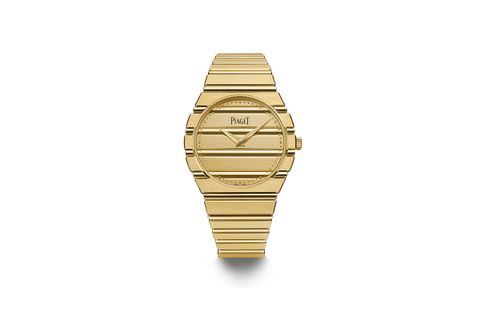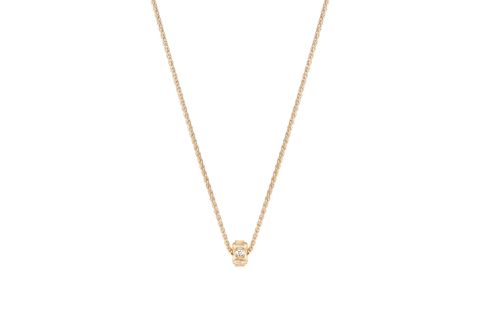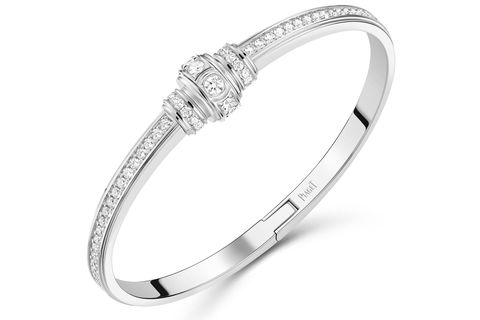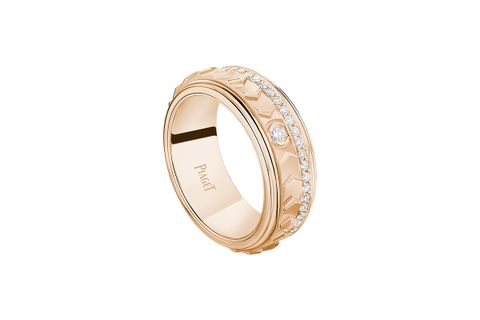As the storied Swiss jeweler and watchmaker Piaget celebrates its 150th anniversary this year (feel old yet?), it has effectively captured the imagination of those tapped into the watch-y zeitgeist. To be sure, the Piaget storm is one that has been brewing for the past couple of years now as the industry-wide obsession over decidedly masculine steel sports watches has given way to a focus on more jewelry-forward, gender-bending vintage pieces. Standing out amongst the crowd is the Piaget Polo, an instant classic when it debuted in 1979, epitomizing the opulence and glamor of the brand during this era. Coinciding with its sesquicentennial (the specific term for a 150th anniversary, fyi) and the vintage-fueled collecting fervor, Piaget shrewdly released the “Polo 79” this year, paying homage to its golden child — served up with a twist — and I was lucky enough to play around with it for a day in New York City.
But first: a quick history lesson. In 1874 (*does the math*…yep, that was 150 years ago!), Georges-Édouard Piaget set up the first Piaget watchmaking workshop at just 19 years old on the family farm in the Swiss Jura Mountains. What started off as a passion project morphed into a commercially viable manufacture from which the brand quietly created high-precision movements and components for other watchmakers. It actually wasn’t until 1943 that Piaget registered its own trademark and started making watches for themselves, still a family-owned and operated business. As the Maison grew, it broke ground making ultra-thin movements — perfectly fitted to elegant dress watches — going so far as to create the thinnest automatic movement in the world in 1960.
This all paved the way for Piaget’s experimentation in watchmaking, applying their expertise as a jeweler to perfect “stone dial” watches fitted with impossibly thin cuts of lapis, tiger’s eye, and more. These beauties were the choice of Piaget’s illustrious clients like Jackie Kennedy, Elizabeth Taylor, and Sophia Loren. As word spread and Piaget took the crown for being the go-to for the most glamorous, the brand needed a piece to encapsulate all of this energy. Enter, without further ado, the Polo.
In 1979, the Polo launched as a design and brainchild of Yves Piaget, a 4th generation Piaget who intimately understood the link between star power and luxury that we take for granted today. At that point, Piaget had been effortlessly nurturing relationships with the “beautiful people” via his legendary “Piaget Society,” a string of global events in which the Maison’s ritzy, jet-setting clientele could mix and mingle (deliciously dripping in the brand’s watches and jewelry, of course). The Polo, then, was a tangible emblem of this luxe elegance, tying the brand to… well…polo, the “sport of kings” favored by the society crowd.
For all the talk surrounding the late, great Piaget Society, there is hardly any photographic evidence to satisfy those of us yearning to live vicariously through the beautiful people. This only adds to its mystique to a generation fatigued by over-sharing through social media. Can you imagine going to a party that isn’t instantly documented and shared online? Hardly…so the next best thing is to adorn ourselves in the pieces evoking this bygone era.
Popularity for vintage Piaget has already been soaring: There’s Elton John’s gem-set Piaget fetching $60K at his Christie’s estate sale. There's the elusive Swiss watch dealer “Mr. A” posting lust-worthy stone dial pieces…celeb “watch spotter” accounts sniping Lil’ Nas X rocking a white gold, malachite dial Piaget at the Met Gala… And the infatuation is only growing. Out and about in New York City, I’ve noticed more vintage, obscure (still affordable) Piaget references claiming wrist real estate of the fashion crowd, with new owners showing them off proudly as if they’re in on the pre-owned market’s best kept secret.
We simply cannot resist the glam, and Piaget’s much-meditated-over “Polo 79” launch fits happily within this growing trend, albeit with updates fit for 2024's modern essence. You may already know that the original Polos famously came equipped with quartz (read: battery) movements. This is still the standard for most jewelry-forward watches, and yet Piaget upped the ante by fitting the new Polo 79 with a mechanical movement, perhaps in an attempt to please the more horologically inclined collectors. To encase the mechanics here, Piaget additionally upped the watch’s case size, the new one presented with a 38mm diameter. This is a mere 4mm more than its predecessor, but every millimeter counts in watchmaking. The Polo 79 took up significant space on my smaller wrists, a presence I felt most notably by its weight. Clocking in at 200 grams, this watch tips the scale in solid 18-karat yellow gold. There’s nothing subtle about it, which is usually what we’re looking for in an all-gold watch. If you got it, flaunt it!
Romping around the Piaget boutique with the Polo 79 around my wrist, I could definitely get a feel for the opulence that defined the mood in which the original was born. Eventually, 1979 gave way to the mid-80s when “greed was good,” ladies lunched, media executives rode around in limos, and New York was the center of the world. It felt fitting, then, that I was wearing this watch casually around Hudson Yards, a retail playground dedicated to this decadent spirit. At $73,000, I personally could not afford this lavish luxury item, but it was fun to make believe I could — and the whole exercise got me seriously thinking about investing in the Piaget brand from a bigger-picture perspective.
Maybe the Polo 79 is too big for me, maybe it’s out of my budget, but maybe I could cultivate a life for myself that brought me closer to the feeling those must have felt dancing the night away at Studio 54, bedecked in their Piaget watches, unbothered and worlds away from the over-surveilled age of the smartphone. This was a luxury that anyone could afford, and I know that if I sat down with Yves Piaget today, he’d agree with me that the best things in life can’t be bought. After all, the first-ever Piaget creation back in 1874 was the pocket watch Georges-Édouard Piaget made for his wife as a token of their love. The Polo also came from a place of passion, a symbol of true friendship designed to celebrate just that. If you can appreciate this and you’re lucky enough to do so wearing the Polo 79, that’s the cherry on top of an already charmed life.
Discover more from Piaget here.






